
Ikuko Tsuchide
(Staff, Electronic Content, Information Management Group,
Technical Services Office, Osaka University Library)
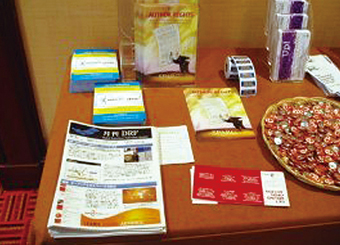
Open-access-related handouts and promotion items from various organizations and institutes
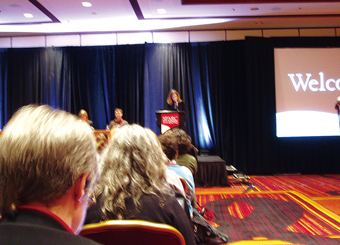
Words of welcome from Heather Joseph
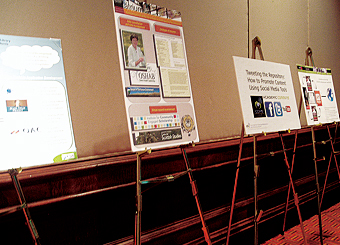
Executive Director of SPARC Poster display at the Innovation Fair
The SPARC Digital Repositories Meeting was held on 8-9 November 2010 in Baltimore, Maryland, US.1 This meeting was hosted by SPARC, SPARC Japan and SPARC Europe, and was held in the same venue as in 2008.2 I had the opportunity to attend this meeting, and this is my report.
The main program consisted of two keynote addresses, four sessions, and an Innovation Fair (poster presentation). Representing Japan, Professor Jun Adachi of the National Institute of Informatics (NII) / SPARC Japan presented a paper at the session entitled “Global Repository Networks.” Although I was unable to attend, many other related events were also scheduled on the days before and after the main program, such as a 10th birthday party for EPrints,3 a major repository software, and a workshop on calculating the actual costs of open-access publishing at the institutional level based on the JISC Houghton Report.4 Here I will limit my report to the most memorable events. For the contents of each session please consult the program page as well as my report to the DRF mailing list.5
The opening keynote was on the topic of “open science” and was given by Michael Nielsen, a pioneer in quantum computation.6 Using concrete examples he discussed how science is spreading outward beyond a handful of professional groups and expanding outside the community centered on scholarly journals. He also showed the border of both professionals and non-professionals were getting blurred these days. His message offered encouragement to the library community by showing that repositories can serve as a means to accomplish this.
The gist of the session entitled “Repository-Based Publishing Services: Strategies for Success (or Failure)” was that journals published at each and every university ought to be deposited in a repository; examples were introduced showing how this has actually been done for journal publications in interdisciplinary fields. At the 2008 meeting there had been a session entitled “Campus Publishing Strategies” at which archives for campus news and small-scale humanities-related university publications were discussed; this time the focus was on the on-campus publishing of journals, i.e. the dissemination of temporary results or those not carried on traditional publishing routes, and the suggestion seemed to be that institutional repositories could provide a new platform for those who are publishing such items. It seems to me, however, that this corresponds to what is called a kiyo (bulletin) in Japan, and the depositing of such material into repositories is already well advanced.
The number of research institutes worldwide (including universities) that have adopted mandatory open-access policies is said to have increased rapidly in 2010. Harvard University is one of them, but despite the mandatory policy, it was reported that faculty members are not self-archiving, and that facilitation by the library and stress-free workflow plans are necessary.
For this meeting an event page was created on Facebook beforehand so that attendees were able to get to know one another in advance; an official hashtag was chosen for twitter, allowing for real-time reports and comments from participants at the meeting as well as discussions with nonparticipants. The high interest in this twitter activity and its effects can be inferred from the reference to it in the news bulletin on the SPARC meeting.7
According to the same article, plans are underway to hold the next meeting in two years’ time in 2012.
References
| 1. |
SPARC Digital Repositories Meeting 2010. http://www.arl.org/sparc/meetings/dr10/ |
| 2. |
SPARC Digital Repositories Meeting 2008. http://www.arl.org/sparc/meetings/ir08/ |
| 3. |
EPrints celebrates its 10th birthday. http://www.ecs.soton.ac.uk/about/news/3445 |
| 4. |
John Houghton, et al. “Economic implications of alternative scholarly publishing models: Exploring the costs and benefits,” JISC, 2009.
http://www.jisc.ac.uk/publications/reports/2009/economicpublishingmodelsfinalreport.aspx |
| 5. |
[drf:2135] Report on SPARC DR Meeting 2010. http://drf.lib.hokudai.ac.jp/drfml/msg02123.html |
| 6. |
Michael Nielsen. http://michaelnielsen.org/blog/michael-a-nielsen/ |
| 7. |
SPARC MEETING HIGHLIGHTS POWER OF REPOSITORIES FOR DRIVING OPEN ACCESS (For immediate release December 9, 2010).
http://www.arl.org/sparc/media/10-1209.shtml |

Takashi Koga
(Research and Development Laboratory,
Kyoto University Library)
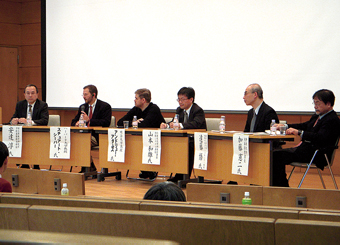
Discussion by panel members
The symposium on 10 December 2010 (Friday) was a significant event providing opportunities to address the current state of open access and future tasks related to it in the US, UK, and Japan and to examine and compare the situation in those countries. Data and a video from that day as well as a summary of reflections from the participants can be found on the SPARC Japan website.1
What was most stimulating for me personally was the lecture by Professor Endo of the Tokyo Institute of Technology. For those involved in research on and implementation of open access in Japan, there seems to be a relative abundance of opportunities, including the talks at this symposium, to hear individual case studies from the standpoint of universities and publishers. By contrast, Professor Endo discussed the state of open-access policy in the US based on his long experience at the Japan Society for the Promotion of Science, a founding agency for academic activities. What I felt was enormously significant about this particular talk was the way he organized and presented the opinions and positions of the various stakeholders in open access: publishers, researchers, academic societies, as well as ordinary citizens in their capacity as taxpayers. In other words, he provided a rough sketch of their differing positions and the points at issue regarding open access, something that is difficult to make clear through case studies alone. Furthermore, Professor Endo contrasted the current state of open-access awareness among ordinary Japanese with that in the United States and proposed possible ways of dealing with it from the viewpoint of researchers, academic societies and the government respectively, offering important suggestions about the future direction of open access in Japan.
There were also some interesting case studies from universities in the US, UK, and Japan. Professor Shieber (Harvard University) suggested a two-stage implementation strategy, a short-term policy and a long-term one: the former consists of an open-access policy at the faculty level while the latter, COPE (Compact for Open-Access Publishing Equity), cuts across universities and research institutes to revolutionize the business model. Professor Adams (Meiji University, formerly of the University of Reading in the UK) introduced wide-ranging strategies aimed at mandating open access at the university level; these ranged from appeals to deans and other upper-level administrators “who have the real power on campus,” to the adoption and use of a repository system. By contrast, when considering the situation in Japan, one has the impression that the direction is from the bottom up: the library plays the central role and makes appeals to individual faculty members on campus; this bottom-up strategy aimed at broadening the on-campus understanding of open access will probably be effective for some time to come. That being said, as Mr. Ojiro of the University of Tokyo Library System noted in his keynote address, at the national level, the Council for Science and Technology Policy has formulated plans to promote open access, and so one gets the impression that this is a good time at both at the government level and at the level of universities and academic societies to direct some energy into the formation of top-down plans and policies. On the other hand, the facilitator of the final panel discussion, Professor Adachi of NII, frankly set forth the tasks confronting Japan when he said, “Although it has been possible to build a point of contact for academic libraries all over the country through SPARC Japan, contact with researchers is still inadequate.”
To sum up, what I sensed at this symposium is the need for policies to deal with open access, but the word “policy” has two meanings. The first is the policy of making research outcomes widely available at the departmental, faculty, and university level. The second are policies on how to provide open access and share research results at the national, regional, and international level and then allocate the resources and personnel to do so. Be that as it may, what is needed in Japan, it seems to me, are effective appeals to and the lobbying of those who have the power to determine these policies, i.e. university leaders and government policymakers.
References
| 1. |
Symposium: “Open-Access Policy for the Dissemination of Research Outcomes from Universities”.
http://www.nii.ac.jp/sparc/en/event/2010/20101210en.html |

● Summary of 2010
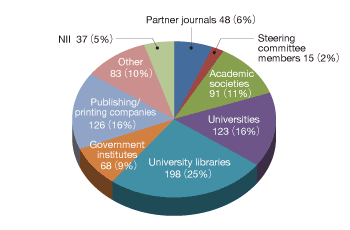
Figure 1: Breakdown of participants
SPARC Japan held eight seminars in FY2010 under the rubric of “SPARC Japan Seminars 2010,” a total of 789 people attended, including those who attended the symposium sponsored jointly with the Japan Association of National University Libraries.
These seminars have been held since FY2003, and until now, attendance by representatives from academic institutions (universities, university libraries, and government institutes) has been low; the breakdown, however, for this fiscal year shows that they accounted for nearly 50 percent (389 persons). Overall attendance for the previous two years was 479 persons in FY2009 (of whom 227, or 47 percent, were from academic institutions), and 617 in FY2008 (161, or 26 percent) so we seem to be achieving our goal of having more people from more diverse backgrounds attend.
In terms of content, in addition to such topics as the latest trends in open access and author ID, four seminars on scholarly journals dealt with the issue from multiple perspectives, i.e., research evaluation, journal publishing overseas, the work of academic societies, and the work of university libraries; these seminars were enormously productive in gathering the various stakeholders together in one room and generating much discussion among them. May we take this opportunity to express our gratitude to all those who were involved in planning the seminars, all those who gave talks or served as facilitators, and all those who attended. Thank you very much.
● Plans for 2011
Plans are underway for FY2011. Based on the questionnaires distributed to participants, we are engaged in an exchange of views using the joint mailing lists for interested persons at academic societies and university libraries (participants include members of SPARC Japan steering committee working group as well as members of working groups handling issues related to institutional repositories under the Organization for Scientific Resources Operations and Coordination in collaboration with university research institutes). Ideas are also being solicited on twitter (hashtag: #sparc2011_kikaku), so please participate in the planning.
|

